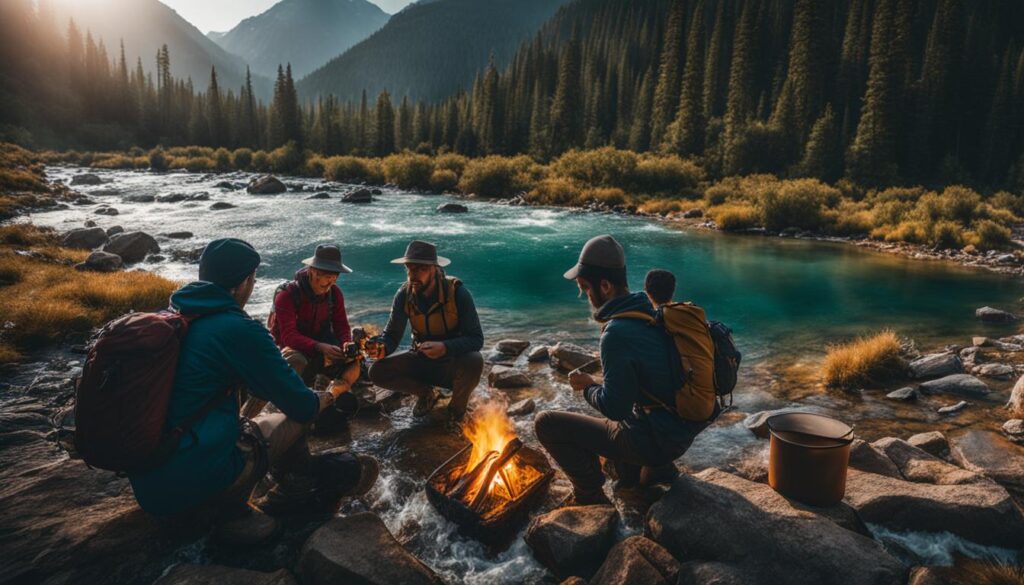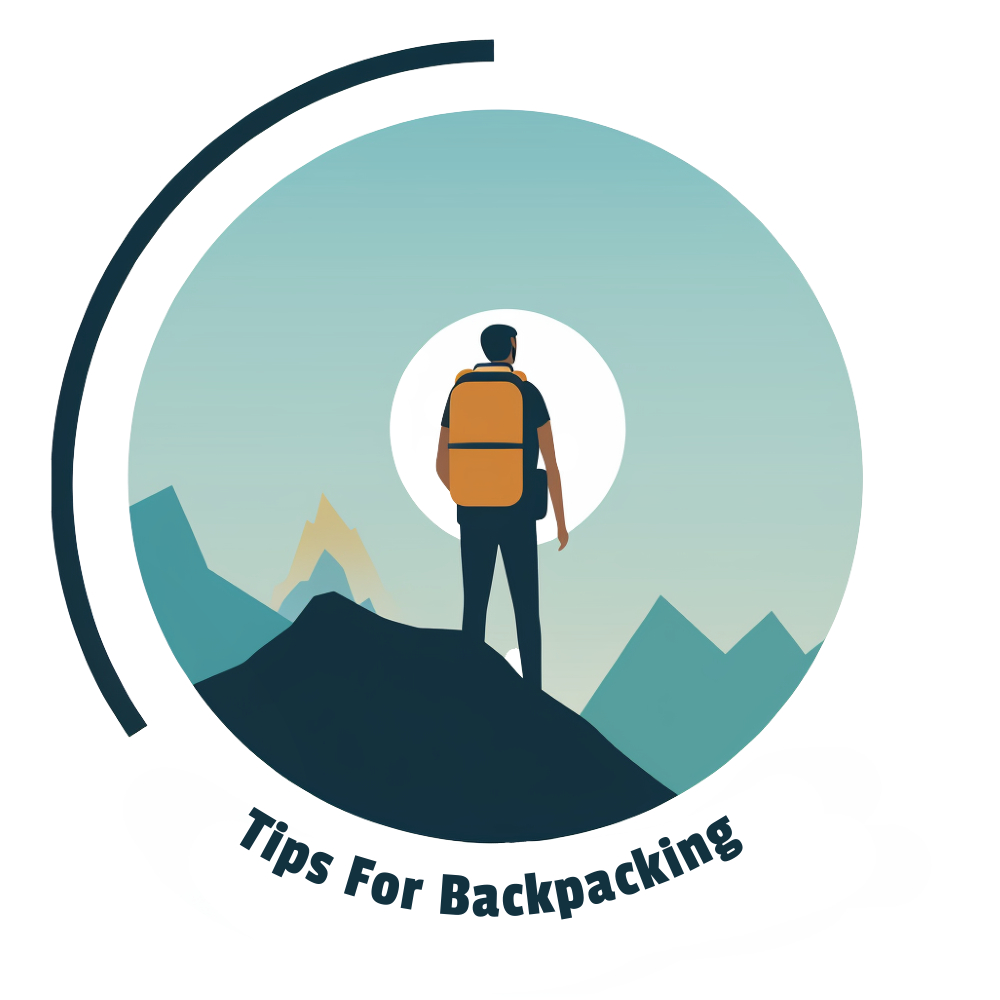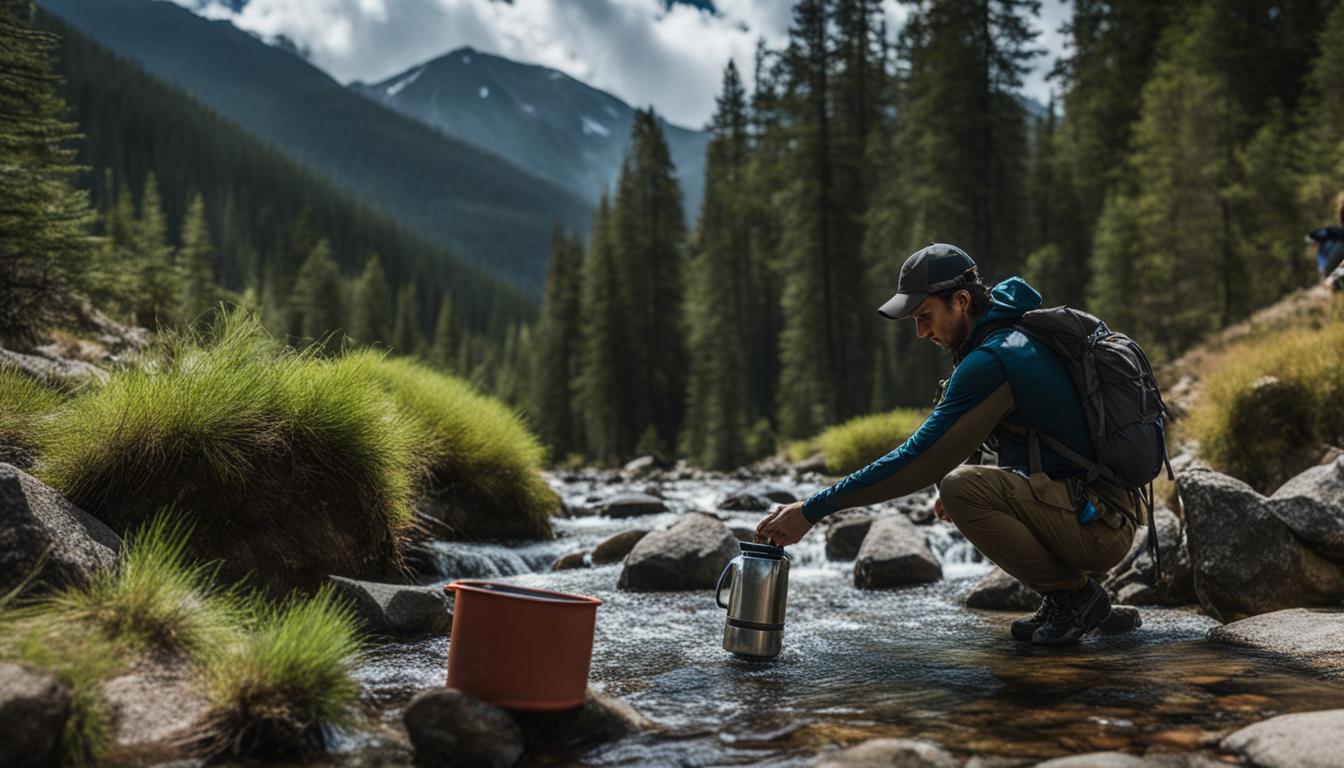When I go backpacking, one thing I can’t compromise on is access to clean drinking water. It’s crucial for my well-being and survival in the wilderness. But finding and purifying water while backpacking can be quite a challenge. Drinking untreated water can make me sick due to potential pathogens and contaminants. That’s why I always make sure to equip myself with effective water treatment methods to ensure hydration and prevent waterborne diseases.
In this article, I’ll share various options and tips for finding and purifying water while backpacking. All the information provided is based on factual data from reputable sources. So let’s dive in and explore the best water purification techniques for backpackers like me.
Key Takeaways:
- Finding clean drinking water is vital while backpacking.
- Drinking untreated water can lead to illness due to pathogens and contaminants.
- Water treatment options include filtration and purification techniques.
- Understanding different methods helps make informed choices for clean water.
- Water filters, purifiers, chemical treatments, UV light, and boiling water are reliable options.
Primary Types of Waterborne Threats and Water Treatment Options
When venturing into the wilderness, backpackers face various waterborne threats that can pose serious health risks. These threats include protozoa, bacteria, and viruses, which can cause illnesses like diarrhea and dehydration. Therefore, it is crucial to prioritize water treatment to ensure the safety of drinking water while backpacking.
There are several water treatment options available to backpackers. One of the primary methods is water filtration, which removes larger microorganisms like protozoa and bacteria from the water. Water filters come in different forms, such as pumps, gravity filters, squeeze filters, and integrated bottles. They are effective in providing clean and safe drinking water in the wilderness.
However, filtration alone might not be sufficient to eliminate all waterborne threats, as viruses are smaller and can pass through most filters. In such cases, water purification techniques are necessary. Water purifiers not only remove bacteria and protozoa but also target viruses, making the water even safer for consumption. Backpackers can choose from various purification options, such as chemical treatments, UV light treatment, and boiling water.
Water Treatment Options:
- Chemical Treatments: These include tablets or drops that release chemicals to kill microorganisms in the water. They are easy to use and lightweight, making them a popular choice among backpackers.
- UV Light Treatment: This method utilizes ultraviolet rays to neutralize contaminants in the water. UV light devices are compact and effective, providing quick purification without the need for chemicals or boiling.
- Boiling Water: Boiling water is a traditional and reliable method to kill germs and make the water safe to drink. It requires a heat source and sufficient time to bring the water to a rolling boil.
By understanding the primary types of waterborne threats and available treatment options, backpackers can make informed decisions to ensure clean drinking water during their outdoor adventures. It is essential to choose the right method based on the water source and potential contaminants to ensure proper hydration and prevent waterborne diseases.
| Waterborne Threats | Water Treatment Options |
|---|---|
| Protozoa | Water Filtration, Water Purification |
| Bacteria | Water Filtration, Water Purification |
| Viruses | Water Purification |
Different Methods for Water Filtration and Purification

When it comes to ensuring clean and safe drinking water while backpacking, there are several methods for water filtration and purification available. Each method has its own advantages and considerations, so it’s important to choose the right one based on the specific circumstances and water source. Let’s explore the different methods:
Water Filters
Water filters are commonly used by backpackers as an effective way to remove bacteria and protozoa from the water. They come in various forms, including pumps, gravity filters, squeeze filters, and integrated bottles. Water filters work by physically straining out the microorganisms as water passes through a porous material. They are highly portable and easy to use, making them a popular choice for adventurers in the wilderness.
Water Purifiers
If you’re looking for a method that goes beyond just filtering out bacteria and protozoa, water purifiers are the way to go. These devices not only remove bacteria and protozoa but also target viruses, which are smaller and require a different approach. Water purifiers often utilize chemical treatments or other advanced technologies to neutralize viruses and make the water safe for consumption.
Chemical Treatments
Chemical treatments, such as tablets or drops, can be used to purify water by killing microorganisms. Common chemicals used for water purification include chlorine dioxide, iodine, and hydrogen peroxide. These treatments are convenient and lightweight, making them a popular choice for backpackers. However, it’s important to follow the instructions carefully, as improper usage or dosage can lead to ineffective treatment or an unpleasant taste.
UV Light Treatment
UV light treatment is another effective method for water purification. These devices use ultraviolet rays to neutralize contaminants and destroy the DNA of microorganisms, rendering them unable to reproduce. UV light treatment is quick, efficient, and does not require the use of chemicals or filters. However, it relies on the availability of batteries or a power source, so it may not be suitable for long backpacking trips in remote areas.
Boiling Water
Lastly, boiling water is a traditional and reliable method to kill germs and make water safe to drink. Boiling water for at least one minute (or longer at higher altitudes) can effectively kill most microorganisms. This method is accessible to everyone and requires minimal equipment. However, it does consume fuel and may not be practical for extended periods of backpacking.
Ultimately, the choice of water filtration and purification method will depend on several factors, such as the availability of resources, the level of contamination in the water source, and personal preferences. It’s important to research and understand the pros and cons of each method before embarking on your backpacking adventure, ensuring that you have a reliable and effective way to ensure clean drinking water throughout your journey.
What are the Best Methods for Purifying Water While Backpacking?
When it comes to carrying water backpacking trips, it’s important to have reliable methods for purifying water. Boiling water is a simple and effective way to kill bacteria and viruses. Using a water filter or purification tablets can also help remove impurities and ensure safe drinking water on the trail.
Conclusion
As I conclude this article, it is crucial to emphasize the importance of water treatment while backpacking. Ensuring access to clean, safe drinking water is fundamental for the well-being of any outdoor enthusiast. Neglecting water purification measures can have severe health consequences, putting a damper on your adventure.
By understanding and implementing reliable water purification methods, you can safeguard yourself against waterborne diseases and enjoy your journey to the fullest. Whether you choose water filters, purifiers, chemical treatments, UV light treatment, or boiling water, each method plays a vital role in eliminating harmful microorganisms and contaminants from your water source.
Always remember to prioritize backpacking water safety measures. Research the water sources in your destination, be familiar with the potential contaminants you may encounter, and select the most suitable purification method accordingly. Don’t take risks with your health; it’s always better to be safe than sorry when it comes to drinking water in the wilderness.
So, the next time you embark on a backpacking adventure, equip yourself with the knowledge and tools necessary to find and purify water effectively. This way, you can confidently explore the great outdoors, stay hydrated, and enjoy your journey while keeping waterborne illnesses at bay. Happy backpacking!

